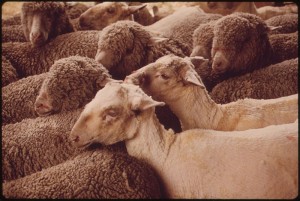Sheep are a great resource around the homestead. They provide delicious meat, and some people even use their milk for cheese, but by far, one of the most often used products is the wool. The great thing about wool is that the sheep produce it continuously so it is a renewable material. If you own sheep, one of the jobs you have to prepare for over the winter is spring shearing.
Shearing sheep is done in the spring so that the animals are able to deal with the weather once they have lost their heavy wool “coat” and also get through the heat of the summer without all that extra insulation.
 Catching Sheep
Catching Sheep
If your sheep are tame and docile and will allow you to walk up to them and catch them, you have it made, but most sheep owners find that having a chute into a small pen will help a lot. You can make your own chute and even create mobile chutes out of cattle panels and t-posts that you can put up and take down again when you don’t need them. Herd the sheep into a pen and catch each one. Have a smaller pen set aside that you can isolate each ewe or ram in to do the shearing without the rest of the animals bouncing around you.
Equipment for Shearing Sheep
Shearing is very easy and requires very few pieces of equipment. Aside from the fencing, all you need is something to cut the wool off of the sheep. There are two basic types—a manual hand-shear that resembles a large, fat pair of scissors, and electric clippers specially outfitted for shearing sheep.
Do not attempt to use household scissors or clippers with standard blades on them. The wool is far too thick and coated with lanolin oil. The oil will gum up small clipper blades.
When Not to Shear
Avoid shearing your sheep after they have eaten. The first thing in the morning before they go out to pasture or before you feed them hay is the best time. A full stomach will be uncomfortable for them when they are on the ground.
Never attempt to shear a wet sheep. If they have been out in the rain, wait until the wool has had a chance to dry. It doesn’t matter what type of sheering tool you use—they will slip and slide over the greasy wool if it is wet.
Getting a Hold on the Sheep
Grasp the ewe or ram under the jaw and while keeping their body sideways to yours, twist their head away from you and around toward their back. Doing this will make the sheep lean into you and fall to the ground toward you with their feet pointed away.
Once down, you can begin to shear, keeping one hand on the sheep’s jaw to control their head and keep them on the ground.
Start at the belly and work your way up and around the back and neck of the sheep, and then flip them over and do the opposite side.
Once you are done, set your sheep free and move on to the next one. It’s that simple!
©2011 Off the Grid News
 Off The Grid News Better Ideas For Off The Grid Living
Off The Grid News Better Ideas For Off The Grid Living



